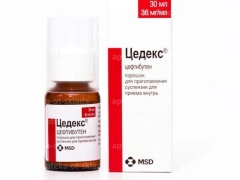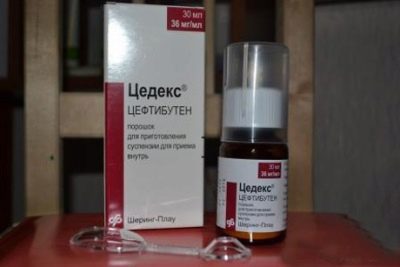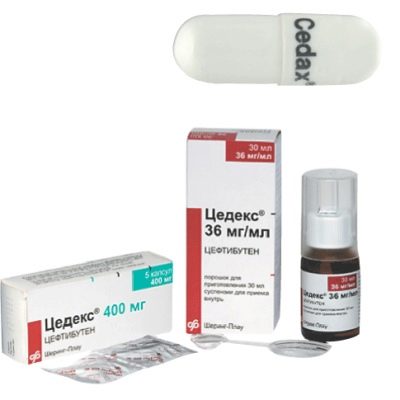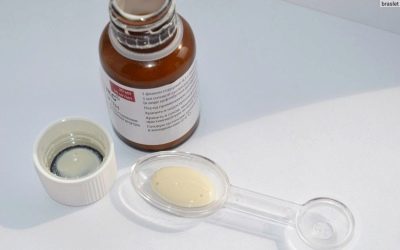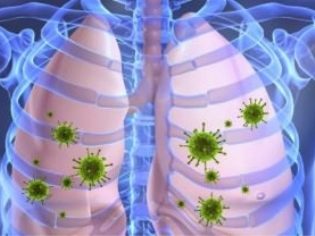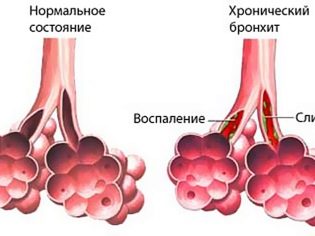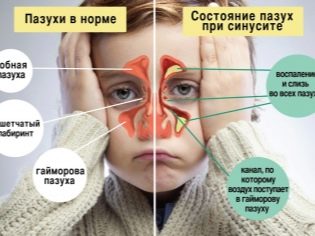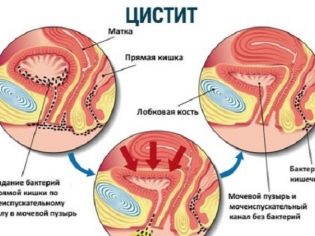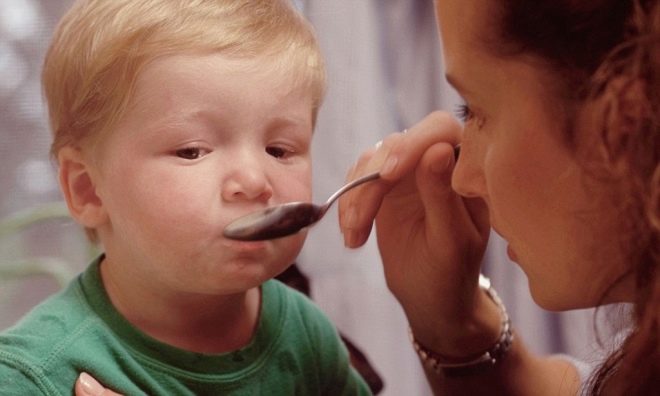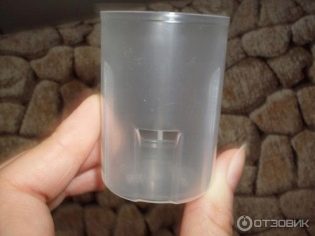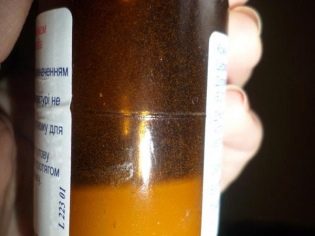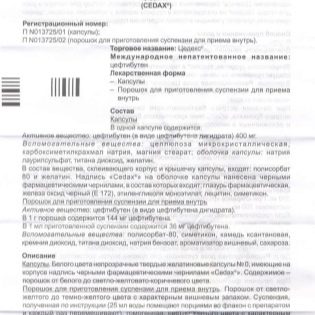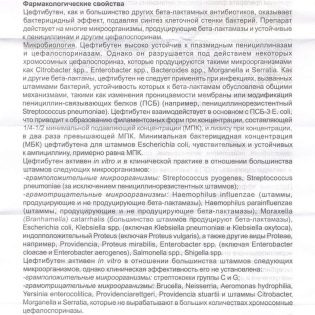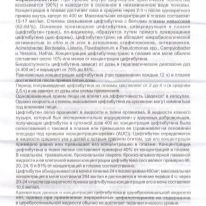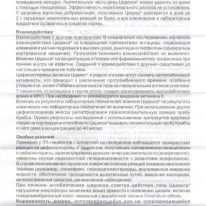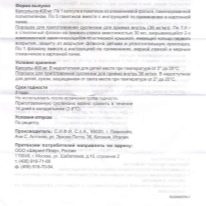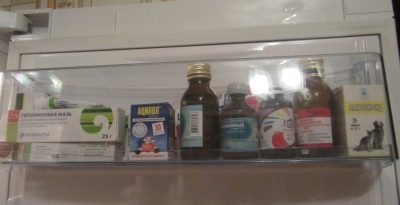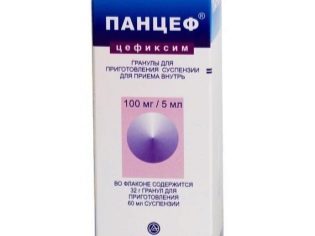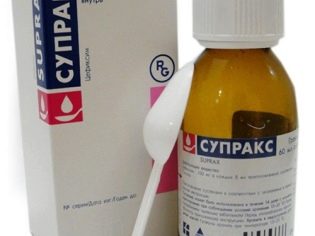Suspension "Tsedeks" for children: instructions for use
Cedex is a popular cephalosporin group antibiotic. It is often prescribed to children, since suspension is a form of this medicine. So that the drug does not cause adverse adverse events and help to cope with the infectious agent, one should know before the treatment when it can be given to the child and what doses of this medicine are allowed in childhood.
Release form
“Cedex” in the form of a suspension is not sold in liquid, but in a dry form. This medicine is a yellow powder that smells like cherry. It is placed in a glass bottle with a capacity of 30 ml in an amount of 8.3 grams. The lid of the bottle is protected from accidental opening by the child, and on top of the bottle there is a plastic cup with a “28 ml” mark, which is required for dilution of the powder.
After mixing with water, a light yellow homogeneous liquid is obtained, which has a sweet aftertaste and characteristic cherry aroma. Additionally, the box has a dimensional double-sided transparent plastic spoon. On the one hand, it is round and holds 1.25 ml of suspension (45 mg of the active ingredient). On the other hand, such a spoon is elongated and contains 5 ml of medication or 180 mg. It also has two labels - 2.5 ml and 3.75 ml, which correspond to 90 mg and 135 mg of the active substance.
In addition to the liquid form, there are also capsules "Zedex", containing 400 mg of the active substance. They can be administered to children over 10 years old if their weight is more than 45 kg.
Composition
The main component of Cedex is called ceftibuten and is presented in powder form as a dihydrate. Its amount in 1 gram of the dry preparation is 144 mg, and after mixing with water, the dosage of such an antibacterial compound is 36 mg in one milliliter. Inactive components of the drug are sodium benzoate, silicon dioxide and xanthan gum.
Simethicone, titanium dioxide and polysorbate 80 are also present in the preparation, and in order to have a pleasant taste of the prepared suspension, sucrose and cherry flavoring are added to the powder.
Operating principle
Cedex represents the third generation of cephalosporin antibiotics; therefore, it has a very broad antimicrobial spectrum of influence on harmful microorganisms. Its mechanism of action is called bactericidal, as ceftibuten suppresses the formation of cell walls, causing the microbes to die.
Taking Cedex is detrimental for Hemophilus sticks, Neisseria, Escherichia, Klebsiell, Pneumococci, Proteus, Moraxells and many other microorganisms. However, some types of strepto-and staphylococci are resistant to medication.
Suspension also usually does not work if the disease is caused by listeria, pseudomonads, enterococci, and some other pathogens noted in the instructions for the drug.
Indications
The drug is prescribed for infections whose pathogen is sensitive to the action of ceftibuten. Suspension required for:
- sinusitis;
- otitis media;
- pharyngitis;
- bronchitis;
- pneumonia;
- tonsillitis;
- gastroenteritis;
- enteritis;
- cystitis;
- pyelitis;
- urethritis.
From what age is appointed?
The use of Cedex suspension is allowed from six months of age. It is impossible to give the drug to babies of the first months of life, since there is no reliable data on the safety of the drug for such young patients.
Children older than 6 months should be prescribed by a doctor.
Contraindications
Cedex is not prescribed if a child has hypersensitivity to its ingredients (both to ceftibuten and to inactive compounds) or to other cephalosporin preparations. Since there is sucrose in the powder, this form of “Cedex” cannot be used even with congenital disorders of carbohydrate metabolism. Precautions in the treatment of suspension require children who are allergic to penicillins, renal failure and diseases of the gastrointestinal tract.
Side effects
A child receiving Cedex may have:
- nausea;
- headache;
- diarrhea;
- vomiting;
- dizziness;
- stomach pains;
- allergic rash;
- drowsiness and other adverse symptoms.
If, after one or several doses of the suspension, any complaints or ailments have occurred, it is recommended to consult a doctor and select another treatment.
Instructions for use
How to prepare a suspension?
To dilute the powder, you need to take clean water and pour it into a measuring cap, which is supplemented with a bottle. Fill the cap with water up to the mark “28 ml” and pour this amount of liquid into the bottle. However, you should not pour out all the water at once - it is best to add liquid in portions and actively stir each time.
In order to distribute all the ingredients of the drug evenly, before each use of “Tsedex” the bottle of syrup should also be shaken.
What dosage should be given to the child?
To determine the right amount of suspension for a particular small patient, you need to know its weight. According to the information in the instructions, a child for every kilogram of his body weight should receive 9 mg of ceftibuten per day. In milliliters it will be 0.25 ml of suspension per 1 kg of baby weight. For example, if a child weighs 12 kg, he is given 3 ml of suspension (0.25x12) per day, of which the tot will receive 108 mg of the active ingredient.
The maximum allowable daily dosage of "Cedex" in children is 400 mg. This amount of antibiotic is contained in 11.1 ml of suspension and corresponds to an approximate weight of a child of 45 kg. If the medication is prescribed to a teenager who weighs more, the daily dose should not exceed 400 mg.
Take before meals or after?
In most diseases, Tsedex is taken once a day. To the effect of the suspension was as effective as possible and its active component quickly entered the bloodstream, and then to infected tissues, it was not recommended to combine the use of Cedex and meals. It is best to take the drug 1-2 hours before meals.
If the child has just eaten, it is better to delay taking the medication and give the baby a suspension after 1-2 hours.
How long to take?
The duration of treatment is affected by the disease in which Tsedex is prescribed. Most often, the medication is prescribed for 5-10 days. If the cause of the disease was pyogenic streptococcus, the medication should last at least 10 days.
It is impossible to stop therapy before the end of the time period prescribed by the doctor, since in this case the bacteria can become resistant to the drug, and the infection will not remain treated and after a while its symptoms will resume.
Overdose
If a child accidentally drinks more of the suspension than the doctor prescribed, taking into account his body weight, this can lead to nausea, headache and other side effects. The drug is not toxic, but in case of overdose, gastric lavage is recommended. If the general condition of the child deteriorates, the doctor should examine it.
Interaction with other drugs
"Cedex" is permissible to use with many other drugs. Studies have shown that the suspension is normally compatible with antacids or theophylline.
Terms of sale
Cedex, like other antibacterial drugs, is available on prescription. Before you buy this suspension to a child, you need to consult with your doctor and get a written prescription from him. The average price of one bottle of powder is 540 rubles.
Storage conditions
Keep the powder in a sealed vial at home should be in a dry place where the temperature does not exceed the mark of 25 degrees heat. Such storage is possible for the entire shelf life marked on the package (it is 2 years).
After mixing with water, the medicine should be stored in the refrigerator for no longer than 14 days. If more than two weeks have passed after preparation of the suspension, the medication should be discarded, even if it is not fully accepted.
Reviews
On the use of "Cedex" in children respond mostly well. The advantages of the drug include its liquid form, fast action and pleasant taste. According to parents, taking such an antibiotic helped to cope with tonsillitis, bronchitis, otitis media and other infections. Side effects, judging by the reviews, the drug provokes extremely rarely. The disadvantages of the suspension include only its high cost, so moms are often interested in cheaper counterparts.
What to replace?
There are no analogues on the active substance in “Tsedex”, therefore, if necessary, to replace such an antibiotic with another medicine, the doctor will prescribe another drug from the cephalosporins group, which belongs to the third generation. It may be:
- «Pancef». Such a preparation in granules contains cefixime. He, like Cedex, is allowed from six months of age. After dilution with water, an orange suspension is obtained from the granules.
- «Suprax». The effect of this drug also provides cefixime. It is most convenient for children to give such a preparation in granules, from which strawberry suspension is prepared. This remedy is also prescribed for patients older than 6 months.
- «Cefotaxime». This antibiotic is released only in an injection form, but can be used from birth. It acts quickly and helps to cope with serious infections.
- «Ceftriaxone». This drug is also represented only by injection form and is allowed even for newborns. Such medicine effectively copes with pneumonia, salmonellosis, peritonitis, sepsis and other dangerous diseases.
If you are allergic to cephalosporins, the doctor may replace “Cedex” with an antibiotic that belongs to another group, for example, macrolide drugs. ”Macropene», «Azithromycin», «Vilprafen" or "Sumamed».
However, it is impossible to give such drugs without consulting a doctor, because they have a different mechanism of action and have their own characteristics of use.
About which antibiotic is better to use for bronchitis, Dr. Komarovsky will tell in the next video.
